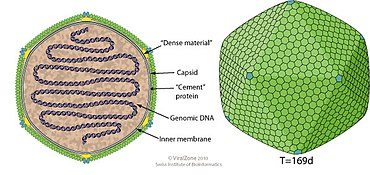Prymnesiovirus
| Prymnesiovirus | |
|---|---|
| Virus classification | |
| (unranked): | Virus |
| Realm: | Varidnaviria |
| Kingdom: | Bamfordvirae |
| Phylum: | Nucleocytoviricota |
| Class: | Megaviricetes |
| Order: | Algavirales |
| Family: | Phycodnaviridae |
| Genus: | Prymnesiovirus |
Prymnesiovirus is a genus of viruses, in the family Phycodnaviridae. Alga serve as natural hosts. There is currently only one species in this genus: the type species Chrysochromulina brevifilum virus PW1 (CbV-PW1). It infects Haptolina brevifila, basionym: Chrysochromulina brevifilum (Edvardsen et al., 2011).[1][2][3]
Taxonomy
Group: dsDNA
- Family: Phycodnaviridae
- Genus: Prymnesiovirus
- Chrysochromulina brevifilum virus PW1
Structure

Viruses in Prymnesiovirus are enveloped, with icosahedral and round geometries, and T=169 symmetry. The diameter is around 100-170 nm. Genomes are linear, around 120-485kb in length.[1]
| Genus | Structure | Symmetry | Capsid | Genomic arrangement | Genomic segmentation |
|---|---|---|---|---|---|
| Prymnesiovirus | Icosahedral | T=169 | Enveloped | Linear | Monopartite |
Life cycle
Viral replication is nucleo-cytoplasmic. Replication follows the DNA strand displacement model. DNA-templated transcription is the method of transcription. The virus exits the host cell by lysis via lytic phospholipids. Alga serve as the natural host. Transmission routes are passive diffusion.[1]
| Genus | Host details | Tissue tropism | Entry details | Release details | Replication site | Assembly site | Transmission |
|---|---|---|---|---|---|---|---|
| Prymnesiovirus | Alga | None | Cell receptor endocytosis | Lysis | Nucleus | Cytoplasm | Passive diffusion |
References
- ^ a b c "Viral Zone". ExPASy. Retrieved 15 June 2015.
- ^ a b ICTV. "Virus Taxonomy: 2014 Release". Retrieved 15 June 2015.
- ^ S.F. Mirza et al: Isolation and characterization of a virus infecting the freshwater algae Chrysochromulina parva, in: Virology Volume 486, December 2015, Pages 105-115, doi:10.1016/j.virol.2015.09.005. See Fig. 4.
